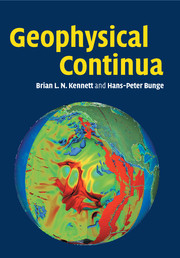Book contents
- Frontmatter
- Contents
- Preface
- 1 Introduction
- PART I CONTINUUM MECHANICS IN GEOPHYSICS
- PART II EARTH DEFORMATION
- 9 From the Atomic Scale to the Continuum
- 10 Geological Deformation
- 11 Seismology and Earth Structure
- 12 Lithospheric Deformation
- 13 The Influence of Rheology: Asthenosphere to the Deep Mantle
- 14 Mantle Convection
- 15 The Core and the Earth's Dynamo
- Appendix: Table of Notation
- Bibliography
- Index
15 - The Core and the Earth's Dynamo
from PART II - EARTH DEFORMATION
Published online by Cambridge University Press: 17 March 2011
- Frontmatter
- Contents
- Preface
- 1 Introduction
- PART I CONTINUUM MECHANICS IN GEOPHYSICS
- PART II EARTH DEFORMATION
- 9 From the Atomic Scale to the Continuum
- 10 Geological Deformation
- 11 Seismology and Earth Structure
- 12 Lithospheric Deformation
- 13 The Influence of Rheology: Asthenosphere to the Deep Mantle
- 14 Mantle Convection
- 15 The Core and the Earth's Dynamo
- Appendix: Table of Notation
- Bibliography
- Index
Summary
Passage from the Earth's mantle to the core marks a transition from a silicate mineralogy to a liquid metallic region dominated by iron. The principal evidence for composition comes from shock-wave equation of state measurements (Section 9.4), reinforced by studies of meteorites. Some lighter component than iron is required in the outer core to match seismological estimates of density. The density deficit is of the order of 10% compared with a liquid iron–nickel alloy. O'Neill & Palme (1998) provide a careful discussion of the merits of the main candidates for a light element component: oxygen, silicon and sulphur. No single element is able to produce the desired density variation and meet geochemical constraints, but a mixture of several elements (Si, O, S, C) might be appropriate. The seismological results are compatible with an adiabatic state through most of the outer core with a change of density of about 10% from the top of the core to the inner core boundary.
The outer core contains 30% of the mass of the Earth and behaves as a fluid on seismic time scales, preventing the passage of seismic shear waves. Slower motions in the liquid core are inferred to be the origin of the Earth's magnetic field through some class of dynamo action.
- Type
- Chapter
- Information
- Geophysical ContinuaDeformation in the Earth's Interior, pp. 379 - 406Publisher: Cambridge University PressPrint publication year: 2008



